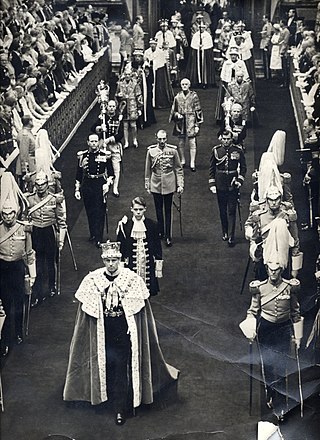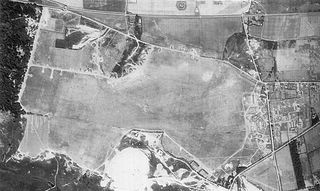
Royal Air Force Leconfield or more simply RAF Leconfield is a former Royal Air Force station located in Leconfield, East Riding of Yorkshire, England.

Royal Air Force Wattisham or more simply RAF Wattisham was, between 1939 and 1993, the name of a Royal Air Force station located in East Anglia just outside the village of Wattisham, south of Stowmarket in Suffolk, England. During the Cold War it was a major front-line air force base, operating Quick Reaction Alert (South), before closing as an Royal Air Force station in 1993. Since 1993 it has been operated by the British Army as Joint Helicopter Command Flying Station Wattisham, or Wattisham Airfield.

Marshal of the Royal Air Force Sir Andrew Henry Humphrey, was a senior officer in the Royal Air Force. He fought in the Second World War as a fighter pilot taking part in the Battle of Britain and also took part in the withdrawal from Aden in November 1967. He served as the Chief of the Air Staff advising the new Labour Government on the implementation of their latest Defence Review. He then served as Chief of the Defence Staff but caught pneumonia within three months of taking office and died shortly afterwards.

Air Marshal Sir Beresford Peter Torrington Horsley, was a senior Royal Air Force commander.

Royal Air Force Martlesham Heath or more simply RAF Martlesham Heath is a former Royal Air Force station located 1.5 miles (2.4 km) southwest of Woodbridge, Suffolk, England. It was active between 1917 and 1963, and played an important role in the development of Airborne Interception radar.

Royal Air Force Warmwell or more simply RAF Warmwell is a former Royal Air Force station near Warmwell in Dorset, England from 1937 to 1946, located about 5 miles east-southeast of Dorchester; 100 miles southwest of London.

Army Aviation Centre (AAC) Middle Wallop is a British Army airfield located near the Hampshire village of Middle Wallop, used for Army Air Corps training. The base hosts 2 (Training) Regiment AAC and 7 (Training) Regiment AAC under the umbrella of the Army Aviation Centre. 2 (Training) Regiment performs ground training; 7 (Training) Regiment trains aircrew on AAC aircraft after they complete basic training at RAF Shawbury.

Flying Training Command was an organization of the Royal Air Force; it controlled flight training units. The command's headquarters were at RAF Shinfield Park, Reading in Berkshire.

No. 662 Squadron was a Royal Air Force Air Observation Post squadron associated with the 21st Army Group and later part of the Royal Auxiliary Air Force. Numbers 651 to 663 Squadrons of the RAF were Air Observation Post units working closely with Army units in artillery spotting and liaison. A further three of these squadrons, 664–666, were manned with Canadian personnel. Their duties and squadron numbers were transferred to the Army with the formation of the Army Air Corps on 1 September 1957. It is now an Apache Helicopter Squadron.
Royal Air Force Catfoss, or more simply RAF Catfoss, is a former Royal Air Force station during the Second World War. It was located 4 miles (6.4 km) west of Hornsea, Yorkshire, England and 8 miles (13 km) north-east of Leconfield, Yorkshire, with the nearest village being Brandesburton.

No. 226 Squadron RAF was a unit of the British Royal Air Force that existed as a bomber squadron during the First and Second World Wars, and as part of the UK's nuclear ballistic missile force in the early 1960s.

No. 3 Flying Training School is a Royal Air Force military training school, which manages elementary flying training for the Royal Navy and Royal Air Force and also for the training of all non-pilot aircrew for the RAF and is home to the Central Flying School Tutor Squadron.
The RAF College of Air Warfare is a former Royal Air Force flying training unit operational between 1962 and 1974. The unit traces its history back to 1942 as the Empire Central Flying School.

No. 7 Flying Training School is a former Royal Air Force flying training school that operated between 1935 and 1994.

No. 25 Group RAF is a former Royal Air Force group.














